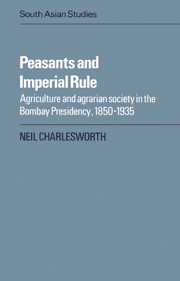Book contents
- Frontmatter
- Contents
- List of maps and tables
- Preface
- Note on technical terms and references
- Maps
- 1 Introduction: the peasant in India and Bombay Presidency
- 2 The village in 1850: land tenure, social structure and revenue policy
- 3 The village in 1850: land and agriculture
- 4 Indebtedness and the Deccan Riots of 1875
- 5 Continuity and change in the rural economy, 1850–1900
- 6 The Bombay peasantry, 1850–1900: social stability or social stratification?
- 7 The agricultural economy, 1900–1935: the critical watershed?
- 8 The impact of government policy, 1880–1935
- 9 The peasant and politics in the early twentieth century
- 10 Conclusions: the problem of differential commercialisation
- Glossary
- Bibliography
- Index
7 - The agricultural economy, 1900–1935: the critical watershed?
Published online by Cambridge University Press: 10 December 2009
- Frontmatter
- Contents
- List of maps and tables
- Preface
- Note on technical terms and references
- Maps
- 1 Introduction: the peasant in India and Bombay Presidency
- 2 The village in 1850: land tenure, social structure and revenue policy
- 3 The village in 1850: land and agriculture
- 4 Indebtedness and the Deccan Riots of 1875
- 5 Continuity and change in the rural economy, 1850–1900
- 6 The Bombay peasantry, 1850–1900: social stability or social stratification?
- 7 The agricultural economy, 1900–1935: the critical watershed?
- 8 The impact of government policy, 1880–1935
- 9 The peasant and politics in the early twentieth century
- 10 Conclusions: the problem of differential commercialisation
- Glossary
- Bibliography
- Index
Summary
If the nineteenth-century history of Bombay's agrarian economy raises complex problems of interpretation, when we turn to the period after 1900 the difficulties multiply. During the first third of the twentieth century the economic influences and fluctuations seem markedly more dramatic and violent than those experienced previously. Price trends are the most conspicuous indices of this. Levels in the Bombay village – partly in consequence of the stabilisation of the rupee in the 1890s – became increasingly shaped by international price movements, but at the very time when they were particularly volatile. Hence rapid inflation during the 1910s and then the sharp falls associated with the onset of the depression during the late 1920s afflicted the countryside and might be expected to have had substantial consequences.
This instability appears to be repeated in climatic trends. There was no further great disaster like 1899–1900, but rainfall levels in many localities still seem lower than was typical during the late nineteenth century and more uneven in distribution between years and over geographical areas. Karjat taluk in the Ahmednagar famine belt, for example, experienced average annual rainfall levels between 1901 and 1921 below even the average for the 1890s and over 20 per cent under the average of 1876–86, further complicated by ‘the irregular and untimely nature of the fall’. Under these circumstances occasional famine persisted and there were outbreaks affecting many areas of the Presidency in 1918–19 and again in 1920–1. Yet these occurrences did not have the deep-seated impact of the great famines of the late nineteenth century. Peasant reaction during these famines and other local ‘scarcities’ seemed, as we shall see, more subtle and flexible, marked by substantial migration.
- Type
- Chapter
- Information
- Peasants and Imperial RuleAgriculture and Agrarian Society in the Bombay Presidency 1850–1935, pp. 204 - 238Publisher: Cambridge University PressPrint publication year: 1985



